THE UNIVERSITY AND OUR COMMUNITY
June 6, 2011
Joel Seligman

In 1924 our University was transformed by a capital campaign from what was in 1920 a College of Arts and Sciences with 577 students and 55 faculty into a national university that by the end of the decade included the new River Campus, the School of Medicine and Dentistry and Strong Memorial Hospital.

In ten days, between November 14th and November 24th, the University of Rochester successfully launched an unprecedented $10 million community capital campaign.

One week later, George Eastman contributed an additional $6 million.

The 1924 Campaign provided much of the $8.2 million cost of purchasing the Oak Hill Country Club and transforming it into the River Campus, ultimately envisioned to be large enough to accommodate 10,000 students.

In 1930, the New York Times would call the results of the capital campaign “Rochester’s New Glory.” The campaign led to the construction of Rush Rhees Library, Bausch and Lomb Hall, Dewey Hall, Morey Hall, Lattimore Hall, Gavett Hall, Strong Auditorium, Todd Union, the Alumni Gymnasium, Fauver Stadium, and the Burton and Crosby residence halls.

The campaign was pivotal in helping fund construction of the School of Medicine and Dentistry;

led to the creation in 1929 of our Institute of Optics;

and the renovation of Sibley Library, the world’s finest music library.

The University’s endowment grew to $16.5 million by 1930, making it the sixth largest in the country. With expanded resources, the campaign transformed our faculty.

The School of Medicine and Dentistry earlier had hired George Hoyt Whipple, later a Nobel laureate, to be the founding Dean of the School of Medicine and Dentistry.

Whipple recruited from Johns Hopkins and other leading schools of medicine so effectively that when the School of Medicine opened in 1925, it had 65 faculty.
How did our predecessors do this? There was first an inspiring vision.

Longtime University supporter George W. Todd persuaded University President Rush Rhees to locate the University’s College on what was then the Oak Hill golf course, near where the new Medical Center was planned.

Lead donors were decisive to the campaign. No one was more important than George Eastman. At a critical meeting in July 1923, after Rhees presented options for the River Campus ranging from $5 to $10 million, Eastman declared, “I think we’d better run up the ten million flag and see what we get.” Eastman pledged the initial $2.5 million to the campaign.

Eastman and Rhees already knew that John D. Rockefeller’s General Education Board would pledge $2.5 million to match Eastman’s commitment. Eastman challenged the Rochester community to raise an additional $5 million.

An energetic campaign leadership focused on what the Rochester Review called “big wonderful gifts,” including

a $200,000 commitment from the Strong family to construct Strong Auditorium in honor of the late Henry Strong, and

$300,000 from the leadership of the Bausch and Lomb Company to construct Bausch and Lomb Hall. There were surprises, including a $300,000 commitment made by an anonymous “friend of the University.” In all, 10 subscriptions of $100,000 each accounted for $1 million of the City total.

What made the Rochester campaign unprecedented was the extent to which it involved our entire community. When the General City Campaign opened on November 14, 1924, 600 volunteers attended a dinner in which targets publicly were announced. A Publicity Committee worked incessantly to articulate the case for the campaign, publishing a near-daily Ten Million Dollar Bulletin during the 10-day public campaign.

Ultimately 15,000 letters were sent to potential donors; successive campaign brochures addressed “Our University at the Cross Roads,” “Our University as Teacher and Neighbor,” and “Build for Rochester
A history of the 1924 Campaign records, “There were subscriptions from newsboys, … school children, American Legion posts, labor unions, fraternal and other organizations.”

In all there were 13,733 contributors, including support from 68.5 percent of living graduates. Underlying this success was a volunteer leadership that included 668 individuals, organized into 4 core divisions, 10 districts, and 50 teams.

The Campaign of 1924 was characterized as “the greatest community project ever undertaken in behalf of higher education.” Along with earlier support for the Eastman School of Music, the Campaign of 1924 created the modern University of Rochester.

Now it is our generation’s turn. We are a great research university. In October of this year, we will publicly launch a transformational campaign. By its conclusion in 2016, we envision:

A University whose quality has fortified its place among the leading 20 research universities in this country based upon measurable achievements in medicine, engineering and life sciences as well as outstanding accomplishment in the humanities, social sciences, performing arts and our professional schools, with critical new facilities such as the Goergen Hall for Biomedical Engineering and Optics.

Underlying this aspiration is our strength in sponsored research. In fiscal year 2010, total sponsored research at the University of Rochester grew 18 percent, excluding the special two-year American Recovery and Reinvestment Act (ARRA), and for the first time in our history exceeded $400 million. So far this year through May 31, 2011, we have received $325 million in research funding.

Normalized for faculty size, this meant that in the 2009 fiscal year, the most recent year for which we have data, the University of Rochester ranked eighth nationally in federal research funding.

Pivotal to our progress is our faculty. They are our core strength, the fundamental reason that students join us here.

This was a year of outstanding faculty achievement. In October 2010, Esther Conwell, a Professor of Chemistry with a joint appointment in Physics, became the first member of the University to be named by the President of the United States as a recipient of the National Medal of Science.

In February 2011, Ching Tang, the Doris Johns Cherry endowed Professor of Chemical Engineering, was named as the recipient of the Wolf Prize for his invention of the organic light-emitting diode (OLED), the technology that gave birth to a multi-billion-dollar industry that is used today in televisions, cell phones, and computer screens because of its energy efficiency, superior resolution, and thinness. Ching is widely known as the “father of modern organic electronics.” His work not only has had broad practical applications but has led his fellow scholars to cite his publications over 10,000 times. One in three Wolf Prize recipients in physics, chemistry, and medicine has gone on to win the Nobel Prize.

Lynne Maquat, the J. Lowell Orbison Chair and Professor of Biochemistry and Biophysics and Director of the Medical School’s Center for RNA Biology, was elected a member of the National Academy of Sciences, one of the highest honors in this nation for our most distinguished scientists, for her work in RNA replication. Lynne has achieved an international reputation for research on cell mechanisms that prevent the production of unwanted proteins that disrupt normal cellular processes and can initiate disease.

Michael Tanenhaus, the Beverly Petterson Bishop and Charles W. Bishop Professor of Brain and Cognitive Sciences, similarly was elected to the American Academy of Arts and Sciences, for his scholarship on how humans derive information from spoken language. One of Tanenhaus’s groundbreaking findings is that the human brain is continually guessing what word a speaker is going to say before the speaker has finished the word. To do this, the brain uses multiple sources of information, including the visual context and the speaker’s likely intentions. These predictions allow us to keep up with the daunting task of processing long series of spoken words while they are being spoken.

In March 2011, former School of Nursing Dean Loretta Ford was selected for the National Women’s Hall of Fame in part for her work developing the unification model of practice, education, and research.

Thomas L. Campbell, the William Rocktaschel Professor and Chair of the Medical Center’s Department of Family Medicine, was chosen president-elect of the Association of Departments of Family Medicine. Campbell is nationally recognized for his work on the role of the family in medical practice and the influence of the family on health.

Cilas Kemedjio, Professor of French and Francophone Studies, has been named the new Director for the Frederick Douglass Institute for African and African-American Studies. The Frederick Douglass Institute not only is named in honor of Rochester’s greatest leader in the fight against slavery, but today the Institute is a major campus center for multicultural programming, including conferences and lecture series.
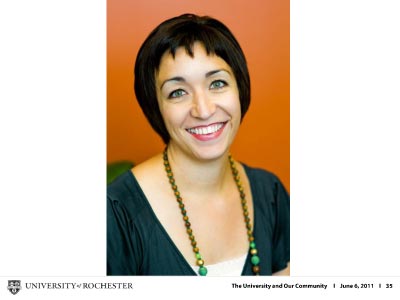
Judy Marquez Kiyama, Assistant Professor in Educational Leadership at the Warner School, was selected as a 2011 Emerging Scholar by the American College Personnel Association. She is one of five new rising scholars recognized from across the nation for contributions in student affairs and higher education.
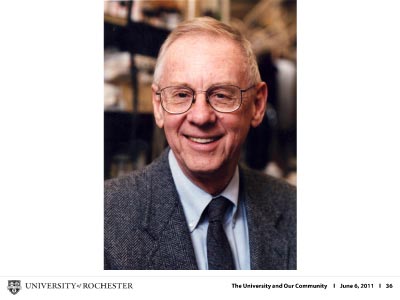
Jack Kampmeier, Professor Emeritus of Chemistry, who died in March of this year, was an inspiring teacher who developed the innovative peer-led team learning method in chemistry courses that has replaced many traditional recitation sections. Peer-led team learning has greatly improved the teaching of chemistry and now many other science and math courses. Today, an estimated 2,000 peer leaders are facilitating workshops at more than 150 colleges and universities for more than 20,000 students a year. Movingly at his memorial service, colleagues spoke of Jack’s unquenchable enthusiasm for improving teaching, often articulated at 7 a.m. weekend breakfasts at the Mt. Hope Family Diner.
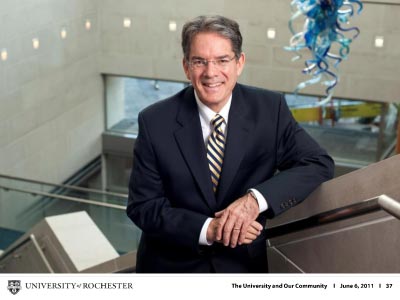
Douglas Lowry later this year will be formally installed as the Joan and Martin Messinger Dean of the Eastman School of Music. Doug has brought Eastman into the 21st century with his leadership of the Eastman Theatre renovation and an ambitious strategic plan, Empowering the Eastman Advantage, that celebrates Eastman’s musical legacy and Eastman’s role as a leader in the future of music.
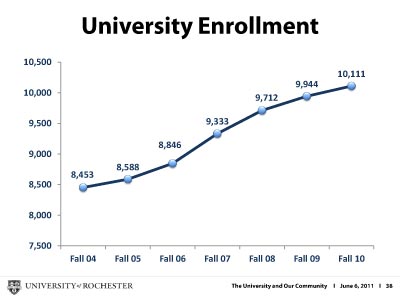
By 2016, we seek a student body that has grown from 8,450 total students in Fall 2004 to 10,000 students, while strengthening quality and diversity. We already have made enormous progress.
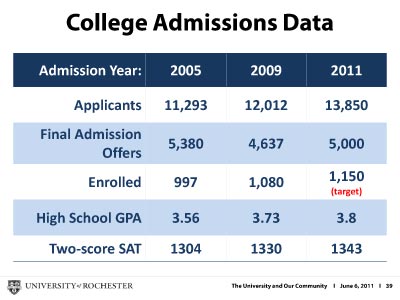
A significant measure of our recent progress involves undergraduate applications to the College of Arts, Sciences and Engineering. Last year, we received a record 12,804 applications. This year that number grew by over 1,000 to 13,850 applicants for the Class of 2015. Our entering class will be the most selective in our history as well as the most diverse in its ethnic, racial, linguistic, and geographic composition. Notably, 15 percent of our entering first-year students are from abroad.
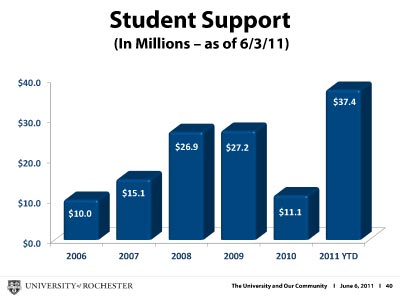
Our Campaign’s ultimate success in part will be measured by our support for our students, most significantly in the form of scholarships and fellowships. Our students are our future. They are our nation’s future. To date, our alumni and friends have contributed over $127 million for our students, bringing us such students as
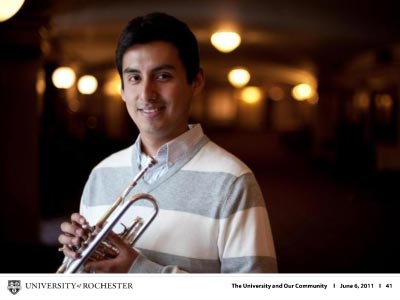
Alan and Jane Handler Scholar Alejandro López-Samamé, who arrived at the Eastman School from his hometown of Lima, Peru and has already achieved success by appearing as first trumpeter with the National Opera of Peru.
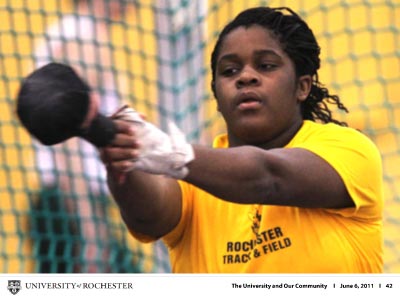
Yaneve Fonge, a Susan B. Anthony Scholarship recipient, the daughter of parents who emigrated from Cameroon, is a nationally ranked track and field weight thrower and this year was a finalist for the Rhodes Scholarship and the recipient of the Presidential Award for Community Service.
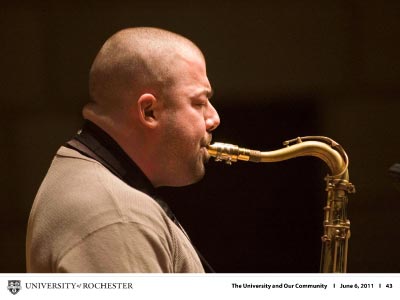
Eastman School of Music doctoral student Matt Stuver was named the best College Jazz Soloist in DownBeat magazine’s 34th Annual Student Music Awards. He was recognized for his performance in the United States premiere of Suite for Soprano Saxophone and 16 Instruments.
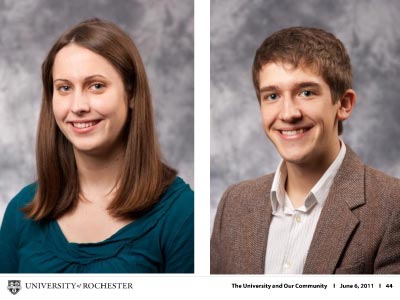
This year our students truly shined. Two Rochester seniors, Nathaniel Lindsey and Hannah Watkins, and one alumnus, David Liebers, were named 2011-2012 United Kingdom Fulbright Scholars. Lindsey, Watkins, and Liebers are our first candidates to succeed in the United Kingdom Fulbright competition and were among only 35 scholars selected from a national pool of more than 700 applicants.
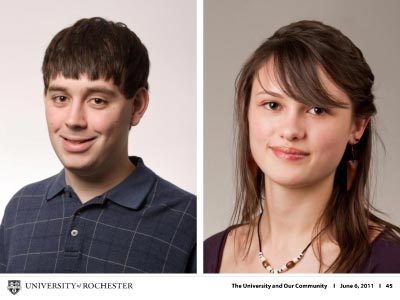
In all, seven University of Rochester students won Fulbrights; eight undergraduate and four graduate students won National Science Foundation Graduate Research Fellowships; 11 students received Gilman International Scholarships; junior Scott Barenfeld won a Goldwater Scholarship; senior Francis Ferraro won a National Defense Science and Engineering Graduate Fellowship; Hannah Watkins was also the University’s first recipient of the Whitaker International Fellowship; and David Liebers was also the University’s first recipient of a Gates Cambridge Scholarship.

On January 26, 2011, Eastman School of Music trumpet student David Aguila appeared on The Tonight Show starring Jay Leno and demonstrated his amazing talent by simultaneously solving the Rubik’s Cube in his left hand while playing Haydn’s Trumpet Concerto with his right hand. You don’t believe me? All right, watch this.
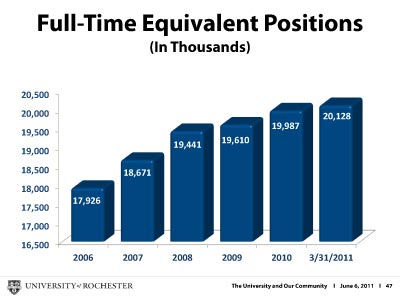
The University of Rochester will continue to grow as the region’s leading employer. As of March 31, 2011, our total full time equivalent employment grew to 20,128 jobs, a year to year gain of 465 jobs, making the University the sixth largest private sector employer in New York State. This was the first period in which we crossed the 20,000 full time equivalent job threshold.
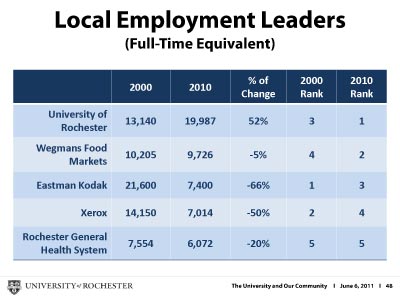
To put this in different terms, the first decade of the 21st century saw a fundamental transformation in the Rochester economy. During that decade the greater Rochester area lost 43,000 manufacturing jobs. The University of Rochester, in contrast, increased employment by approximately 50 percent, having begun the 2000 decade with 13,140 jobs.
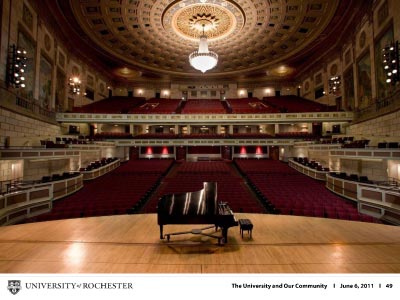
Even before our October 2011 public announcement of our Campaign, we have been on the move. Between December 6 and 12, 2010, we celebrated the completion of the $47 million Eastman Theatre Renovation and Expansion project with a six-day Festival Week. Eastman now achieves George Eastman’s dream with a renovated Kodak Hall, the new Hatch Recital Hall, the Wolk Atrium with its distinctive Chihuly sculpture, and Betty’s Cafe.
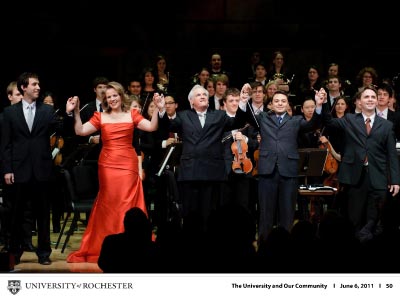
On February 20, 2011, Renée Fleming returned to her alma mater for a gala dedicatory concert to celebrate the new Eastman Theatre, concluding with an extraordinarily memorable final encore with three Eastman students. The concert also created the Renée Fleming Endowed Scholarship Fund, which will provide support for students majoring in voice.
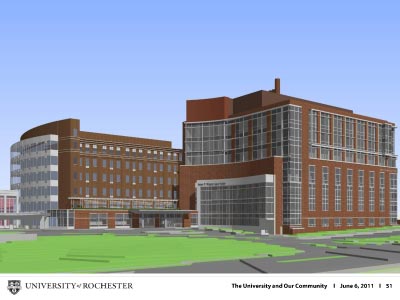
Our Campaign will focus on great programs. We will provide “Medicine of the highest order” exemplified by the expansion of the Wilmot Cancer Center. This new three-story addition will provide 30 new medical oncology beds, a new 12-bed bone marrow transplant unit and the provision of imaging services for patients in the Wilmot Cancer Center.
The Medical Center continues to develop plans for the Golisano Children’s Hospital. We have a critical need for private pediatric rooms, more space to accommodate families, and the ability to bring all of our pediatric services together in a more cohesive way. This is a priority for the Medical Center and the University – to provide 21st century care first for our children, and ultimately for all of the Medical Center’s patients. In the years to come, the renovation of our clinical care will be one of the most important ways we serve the greater Rochester community.
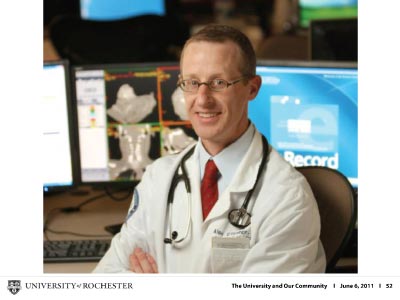
On March 5, 2011, Strong Memorial Hospital launched its new $78 million Electronic Health Records system, the single largest information technology project in University history, with the initial rollout to inpatient units, emergency departments, pharmacies, and outpatient oncology. eRecord replaces several disparate information systems and creates a single integrated Electronic Health Record system shared by the University’s entire medical enterprise, which gives all caregivers a comprehensive view of a patient’s medical information. This ultimately will improve patient care by streamlining workflows and eliminating duplicate testing and transcribing. The ultimate goal is one patient, one record, one system. Highland Hospital will launch eRecord this month, and ambulatory practices are scheduled to integrate eRecord by the summer of 2012.
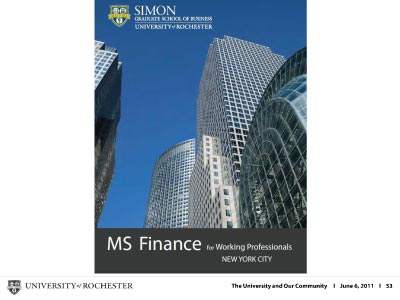
In March 2011, the Simon School initiated a new master’s program in New York City, concentrating on Finance. New York City also served as the backdrop for the 2nd Annual Simon Graduate School of Business Conference. This year, nearly 300 people gathered to hear experts from industry, government, and academia discuss “Emerging Risks to America’s Financial Stability.” Among the speakers were New Jersey Governor Chris Christie, SuperFreakonomics co-author Steven Levitt, and the former United States Secretary of Commerce Peter G. Peterson. Peterson was honored as the Simon School’s inaugural Executive of the Year.
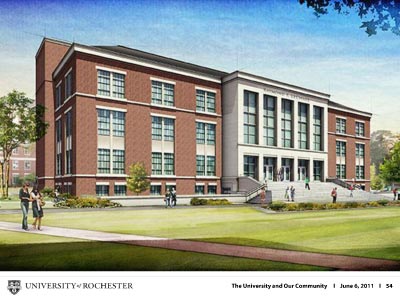
On March 15, 2011, Board Chair Ed Hajim and I presided at the announcement that the University Board had approved the construction of a $24 million new home for the Warner School of Education. The new building will be named the Raymond F. LeChase Hall in recognition of the lead gift made by Raymond’s son, University Trustee Wayne LeChase, and Wayne’s wife, Beverly.
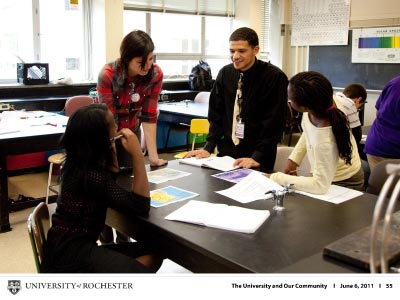
K-12 education is one of the great social challenges of the 21st century. While many universities have scaled back their support of schools of education, the University of Rochester is determined to invest in K-12 education as part of our commitment to the greater Rochester community and, most of all, our children.
Our city schools face daunting challenges. The Rochester City School District continues to experience some of the worst graduation rates in the country with only 46 percent of high school students graduating on time. The New York State Department of Education late last year indicated that only 5 percent of Rochester high school graduates are prepared for college. These rates are among the lowest in the state.
These data should be seen in context. Rochester also ranked 11th nationally in child poverty, with 42 percent of our children under the age of 18 living in poverty, the highest poverty rate among the State’s five largest school districts.
The way forward for the 135,000 K-12 students in Monroe County is education. It is far more difficult for those without a high school diploma to find jobs and impossible for most to attend college. Without success in K-12, we are freezing out of the American Dream about half of Rochester’s high school students. This is a crisis of fundamental consequence. We owe our children a better future.
The University’s commitment to a new building for our Warner School of Education is our way of signaling our determination to be part of the solution to this great challenge. We look forward to working with the City and Warner School leadership on ways to strengthen K-12 education in Rochester.
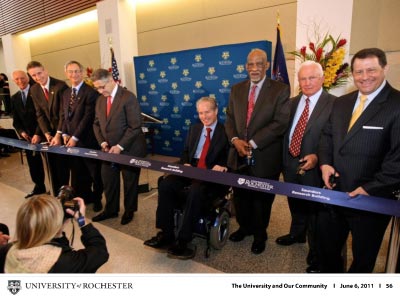
On April 8, 2011, New York Lieutenant Governor Bob Duffy and Assembly Speaker Sheldon Silver joined us for the dedication of the nation’s first Clinical and Translational Science Building.
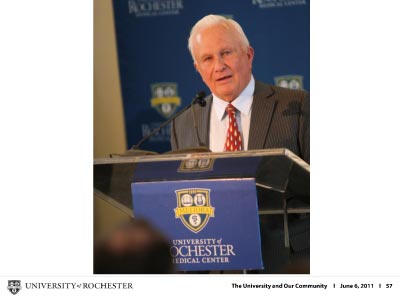
Brad Berk, Medical Center Chief Executive Officer, publically announced that the new 200,000 square foot building would be known as the Saunders Research Building in honor of E. Philip Saunders whom Brad earlier that week announced had made a $10 million gift to the Medical Center.
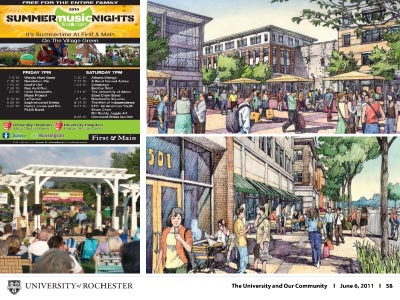
A grand highlight of this year was the selection of Fairmount Properties of Cleveland to be the University’s development partner for our potential 16-acre College Town on Mt. Hope Avenue between Elmwood Avenue and Crittenden Boulevard. Fairmount has created successful spaces and programming events and has already submitted a proposed vision for Mt. Hope that includes services in support of the campus and the community.
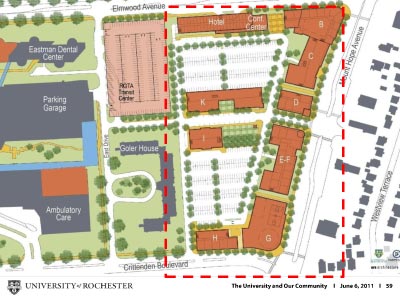
College Town, if approved by our Board, will include up to 500,000 square feet with a hotel and conference center, a YMCA that will offer health and fitness programs in collaboration with the Medical Center, child care, a gourmet grocery store, office space, and other retail establishments. A transit center operated by the Regional Transit Authority would facilitate public transportation to the University and provide an eagerly awaited parking facility.
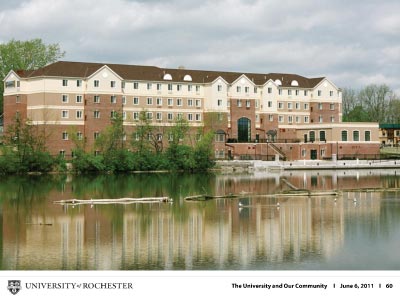
Like the earlier development at Brooks Landing, College Town will add strength to another adjoining neighborhood with vitally needed retail and community gathering spaces.
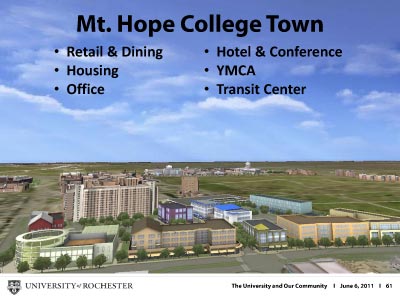
The project has already received the enthusiastic support of many in the neighborhood.
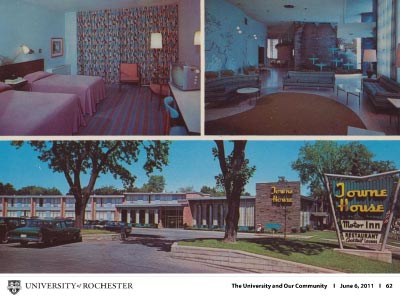
Alas, College Town will mean the end of the Towne House Motor Inn and Restaurant, for decades celebrated, among other things, as Rochester’s only fireproof inn.
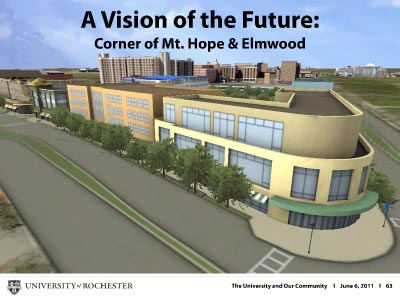
The Towne House potentially will be succeeded by a 25,000 square foot bookstore on the corner of Mt. Hope and Elmwood.
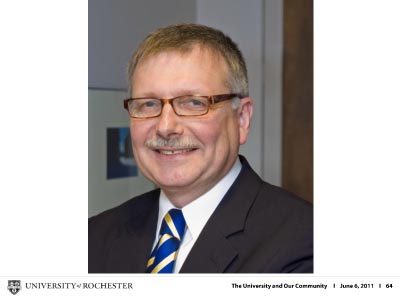
Our Senior Vice President for Administration and Finance Ron Paprocki is leading University efforts in this very important project, including detailed due diligence.
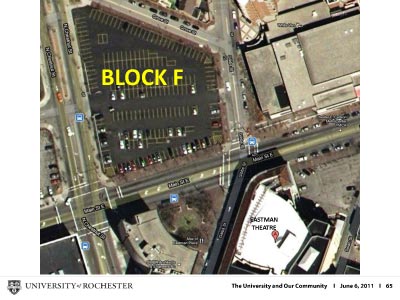
In a separate development, in April of this year, the Rochester Cultural Center Commission accepted the University’s offer to purchase Block F, a 1.6 acre parcel of land on East Main Street across the street from the Eastman School of Music. This parcel is of strategic importance to the Eastman School since it provides an opportunity for the expansion of the School’s facilities in the future. The sale will be complete upon approval by the City Council and the County Legislature as well as the University’s environmental review. The intent is for the University to engage a private developer to undertake a mixed use development that likely will include residential and retail space.
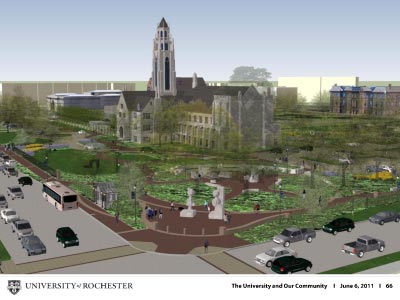
The Memorial Art Gallery, thanks to underwriting from the EDMAC Foundation and long time Gallery patron Joan Feinbloom, has commissioned site- specific works by noted American sculptors Jackie Ferrara and Wendell Castle for its Centennial Sculpture Park, scheduled to open during the Memorial Art Gallery’s centennial year, 2013-2014.
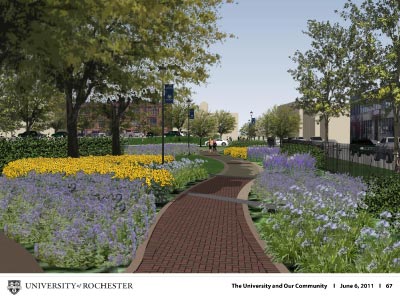
The new Sculpture Park will be a highlight of MAG’s gala celebration of its first 100 years as one of this nation’s great regional art museums.
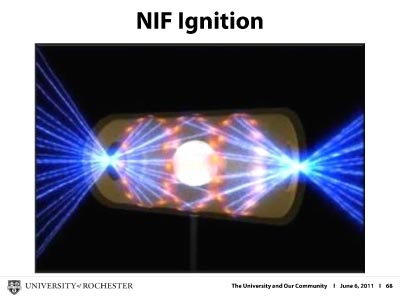
This year our Laboratory for Laser Energetics also celebrates its 40th anniversary. The Laser Lab is participating with Lawrence Livermore and other national labs in one of the 21st century’s most critical energy experiments – the attempt to achieve nuclear fusion ignition in the laboratory, popularly known as NIF. This is the Manhattan Project of our time; as one scientist put it, “a holy cow 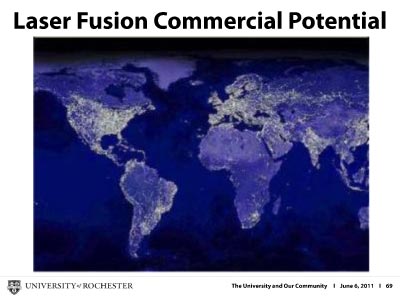
T Laser fusion, unlike current nuclear power plants, is safe, cannot melt down, is carbon free, nonradioactive, and potentially will provide an inexhaustible source of energy.
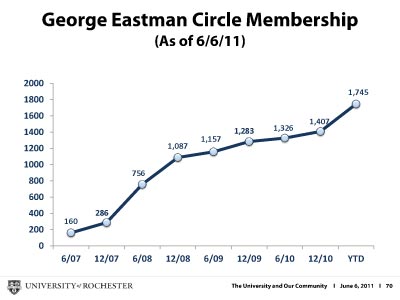
We have built the foundation for a comprehensive capital campaign. In four years, the George Eastman Circle, our University annual giving society, has grown to 1,745 members, each of whom has made a five-year pledge that has helped us double our Annual Fund in five years.
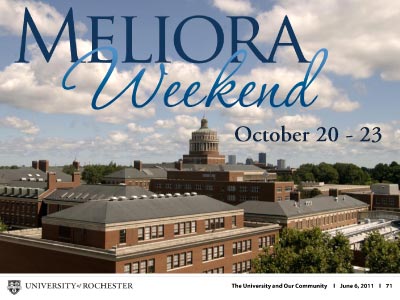
We are on our way to the public announcement of the University’s largest capital campaign in our history at our October 2011 Meliora Weekend. All of you are invited.
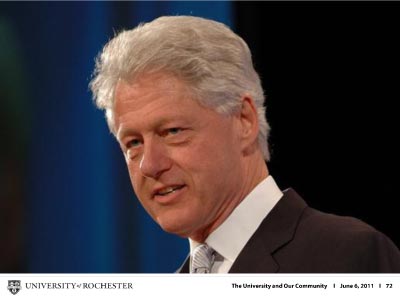
Former President Bill Clinton will be our keynote speaker. Meliora Weekend 2011 will feature over 200 events for alumni, parents, and friends from across the University. We anticipate that this year’s Meliora Weekend will be the best attended in our history.
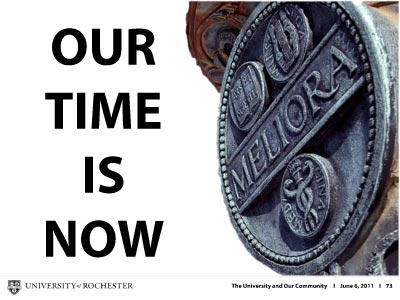
Our time is now. We have the capacity, the will and the talent. We build on enormous strengths – we are home to one of the greatest faculties of any research university in this country. We have world class programs in fields as varied as music, optics, financial economics, and neuromedicine. I believe – all of us at the University believe – in our motto, Meliora, ever better. We seek to take a great research university and make it stronger. We seek to build an ever stronger Rochester. For we will never forget that we are an urban university, proud to be part of the Rochester community, deeply aware that our progress and Rochester’s success are inextricably linked.
Thank you.
